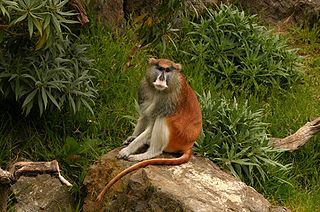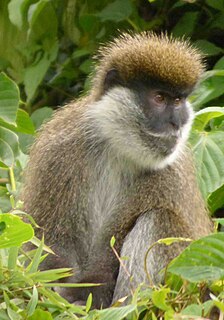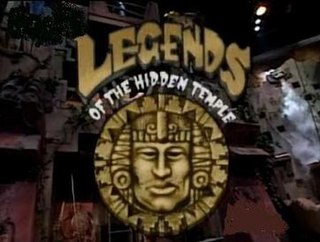This page is based on this
Wikipedia article Text is available under the
CC BY-SA 4.0 license; additional terms may apply.
Images, videos and audio are available under their respective licenses.

Erythrocebus is a genus of Old World monkey. Both species in this genus are found in Africa, and are known as patas monkeys. Recent phylogenetic evidence indicates that this genus is the closest relative of the vervet monkey, suggesting nomenclatural revision. While formerly considered a monotypic genus, studies have revealed that some of the northeast African populations are a distinct species, E. poliophaeus.

The Old World monkeys is the common English name for a family of primates known taxonomically as the Cercopithecidae. Twenty-four genera and 138 species are recognized, making it the largest primate family. Old World monkey genera include baboons and macaques '. Common names for other Old World monkeys include the talapoin, guenon, colobus, douc, vervet, gelada, mangabey, langur, mandrill, surili, patas, and proboscis monkey. Phylogenetically, they are more closely related to apes than to New World monkeys. They diverged from a common ancestor of New World monkeys around 55 million years ago, before South America and Africa separated about 50 million years ago.

The guenons are the genus Cercopithecus of Old World monkeys. Not all members of this genus have the word "guenon" in their common names; also, because of changes in scientific classification, some monkeys in other genera may have common names that include the word "guenon". Nonetheless, the use of the term guenon for monkeys of this genus is widely accepted.

The vervet monkey, or simply vervet, is an Old World monkey of the family Cercopithecidae native to Africa. The term "vervet" is also used to refer to all the members of the genus Chlorocebus. The five distinct subspecies can be found mostly throughout Southern Africa, as well as some of the eastern countries. Vervets were introduced to Florida, St. Kitts, and Cape Verde. These mostly herbivorous monkeys have black faces and grey body hair color, ranging in body length from about 50 centimetres (20 in) for males to about 40 centimetres (16 in) for females.

The Cercopithecinae are a subfamily of the Old World monkeys, which comprises roughly 71 species, including the baboons, the macaques, and the vervet monkeys. Most cercopithecine monkeys are limited to sub-Saharan Africa, although the macaques range from the far eastern parts of Asia through northern Africa, as well as on Gibraltar.

The grivet, also known as African green monkey and savannah monkey is an Old World monkey with long white tufts of hair along the sides of the face. Some authorities consider this and all of the members of the genus Chlorocebus to be a single species, Cercopithecus aethiops. As here defined, the grivet is restricted to Ethiopia, Sudan, Djibouti and Eritrea. In the southern part of its range, it comes into contact with the closely related vervet monkey and Bale Mountains vervet. Hybridization between them is possible, and may present a threat to the vulnerable Bale Mountains vervet. Unlike that species, the grivet is common and rated as Least Concern by the IUCN.

The Nyungwe Forest is located in southwestern Rwanda, at the border with Burundi, to the south, and Lake Kivu and the Democratic Republic of the Congo to the west. The Nyungwe rainforest is probably the best preserved montane rainforest in Central Africa. It is located in the watershed between the basin of the river Congo to the west and the basin of the river Nile to the east. From the east side of the Nyungwe forest comes also one of the branches of the Nile sources.

Vero cells are a lineage of cells used in cell cultures. The 'Vero' lineage was isolated from kidney epithelial cells extracted from an African green monkey. The lineage was developed on 27 March 1962, by Yasumura and Kawakita at the Chiba University in Chiba, Japan. The original cell line was named "Vero" after an abbreviation of verda reno, which means "green kidney" in Esperanto, while vero itself means "truth" in Esperanto.

The L'Hoest's monkey, or mountain monkey, is a guenon found in the upper eastern Congo basin. They mostly live in mountainous forest areas in small, female-dominated groups. They have a dark coat and can be distinguished by a characteristic white beard.

The malbrouck is an Old World primate from Africa that belongs to the genus Chlorocebus. The species is sometimes classified as a subspecies of the vervet monkey, or of the widespread grivet.

Cercopithecini is a tribe of Old World monkey that includes several monkey species, including the vervet monkeys, talapoins and the guenons, all in Africa.

The Bale Mountains vervet is a terrestrial Old World monkey endemic to Ethiopia, found in the bamboo forests of the Bale Mountains. It was originally described as a subspecies of the grivet. All species in Chlorocebus were formerly in the genus Cercopithecus.

The tantalus monkey is an Old World monkey from Africa that ranges from Ghana to Sudan. It was originally described as a subspecies of the grivet. All species in Chlorocebus were formerly in the genus Cercopithecus. It is a common species with a wide range, and the International Union for Conservation of Nature has rated its conservation status as being of "least concern".

River Gambia National Park is a national park in the Gambia.
















